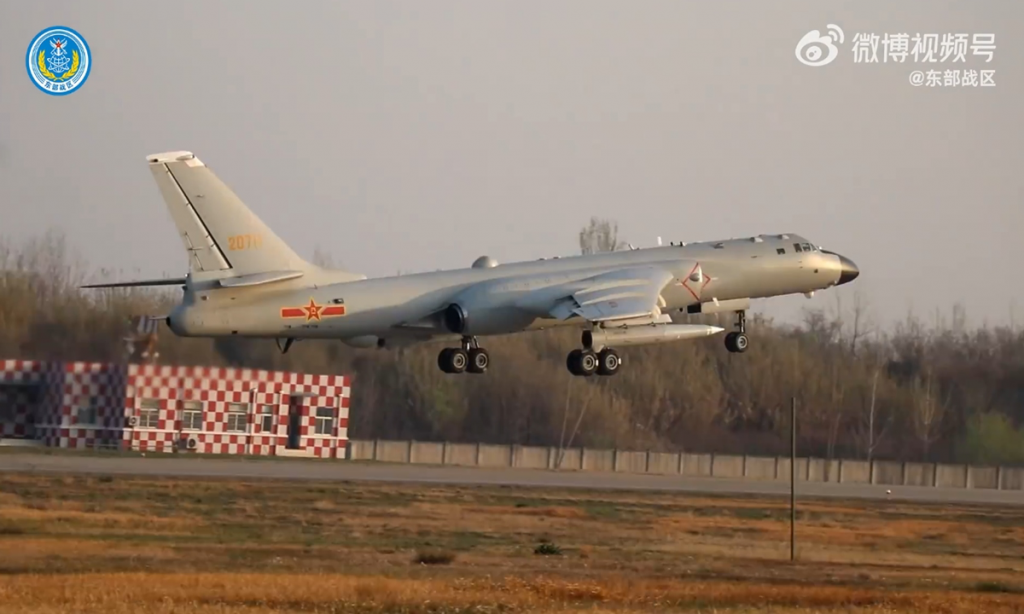By Guo Yuandan and Liu Xuanzun

An H-6K bomber takes off during the joint exercises around Taiwan island on April 1, 2025. Senior Colonel Shi Yi, spokesperson of the Eastern Theater Command, says that on April 1, the PLA Eastern Theater Command starts to conduct joint exercises, organizing its army, navy, air and rocket forces to close in on the Taiwan Island from multiple directions.
Organizing its army, navy, air and rocket forces, the Chinese People’s Liberation Army (PLA) Eastern Theater Command launched joint exercises around the island of Taiwan on Tuesday. Upon orders, the forces mobilized from all directions, assembled and encircled the island. The exercises showed three major capabilities of the PLA, namely joint operation, precision strike on key targets, and seizure of control, an expert told the Global Times.
On Tuesday, the PLA Eastern Theater Command organized its vessel and aircraft formations, in coordination with conventional missile troops and long-range rocket launching systems, to conduct drills of air interception, assault on maritime targets, strikes on ground objects, and joint blockade and control, in waters to the north, south, and east of Taiwan Island, the PLA Eastern Theater Command said in a statement.
These drills are aimed at testing the troops’ capabilities of carrying out integrated operations, seizure of operational control, and multi-directional precision strikes, the statement reads.
The statement came after Senior Colonel Shi Yi, spokesperson of the PLA Eastern Theater Command, announced earlier on Tuesday that the PLA Eastern Theater Command started to conduct joint exercises, organizing its army, navy, air and rocket forces to close in on the Taiwan Island from multiple directions.
The drills mainly focus on sea-air combat-readiness patrols, joint seizure of comprehensive superiority, assault on maritime and ground targets, and blockade on key areas and sea lanes so as to test joint operations capabilities of its troops. It is a stern warning and forceful deterrence against “Taiwan independence” separatist forces, and it is a legitimate and necessary action to safeguard China’s sovereignty and national unity, Shi said.
The military channel of China Central Television (CCTV) provided some details of the exercise.
In the early hours of Tuesday, a conventional missile unit of the PLA Rocket Force that was tasked with a strike mission maneuvered toward multiple preset positions from multiple directions under dim light. Reinforced by target intelligence, mission planning and data support, dozens of launch units conducted simultaneous fire tracking and carried out multiple waves of simulated strikes with a large number of missiles, before orderly evacuating their positions.
At frontlines along the coast, a modularized long-range rocket fire strike unit affiliated with a brigade of the army of the PLA Eastern Theater Command arrived at mission area on time, as launch vehicles took launch positions and launched consecutive simulation strikes on targets.
In the air, the PLA Eastern Theater Command’s air force sortied dozens of fighter jets and bombers in multiple batches. Supported by electronic warfare and tanker aircraft, they advanced in the Taiwan Straits and at the northern and southern ends of Taiwan Island as a coordinated system. Under the guidance of early warning aircraft, the warplanes worked in conjunction with warships and surface-to-air missile installations to practice regional control and aerial interception.
Upon arriving at designated waters, naval vessels of the PLA Eastern Theater Command quickly started combat deployments, with multiple intelligence systems engaged to capture hostile situation, and weapon systems ready to fire upon order, according to the CCTV report.
Zhang Chi, a professor at the National Defense University, told Global Times on Tuesday that the exercise featured sea-air combat readiness patrols, seizure of comprehensive control, anti-sea and land attacks, as well as blockade and control of key areas and routes.
These training courses have been routinely conducted in recent PLA drills near Taiwan Island, including the sea-air combat readiness patrol and the Joint Sword exercises in 2023, as well as Joint Sword-2024A and Joint Sword-2024B in 2024. Zhang noted that the purpose of these exercises is to let the DPP authorities and “Taiwan independence” secessionist forces routinely feel the PLA’s firm will and strong capability in defending national sovereignty and countering secessionist forces.
Tuesday’s drills primarily showcased three capabilities of the PLA. First is the joint operational capability, as the PLA Eastern Theater Command organized its army, navy, air force, and rocket force, along with reconnaissance and intelligence resources, to fully test the troops’ ability to conduct integrated maneuvers, Zhang said.
The second capability is conducting precision strikes on key targets. The drills practiced anti-sea and land attacks, testing the troops’ precision strike capabilities on key targets of the Taiwan authorities from multiple directions, Zhang said.
The third is the capability to seize control, as the PLA practiced the seizure of air superiority, control of the sea, and control of information, the expert said.
 Africa -China Review Africa -China Cooperation and Transformation
Africa -China Review Africa -China Cooperation and Transformation
